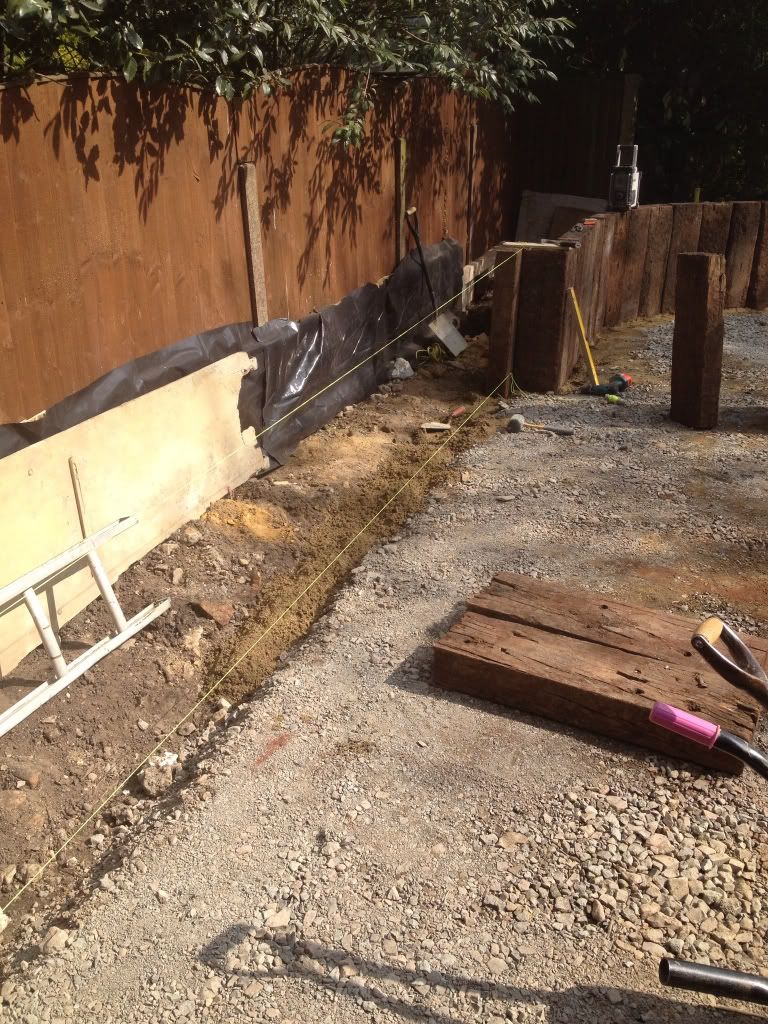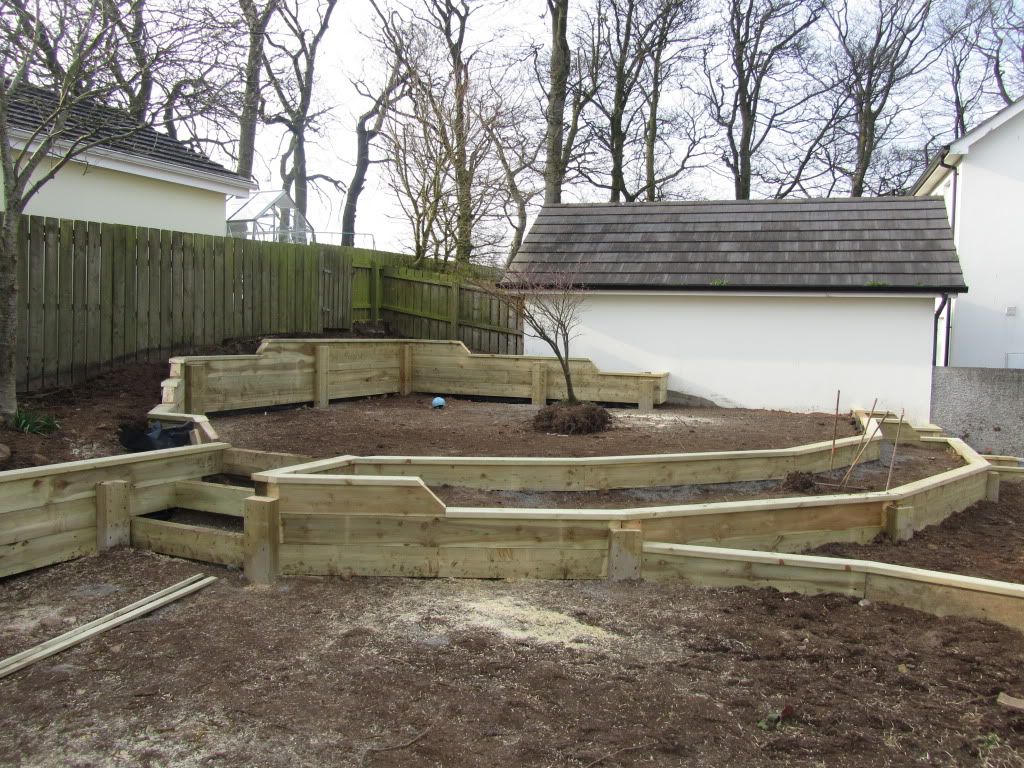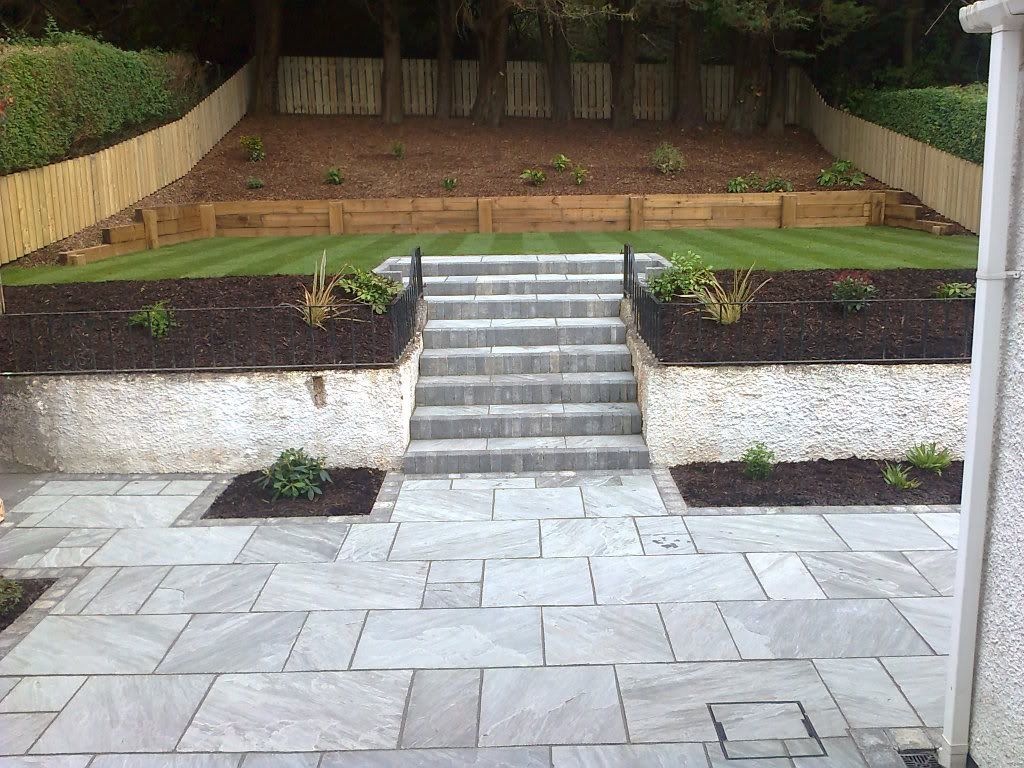Page 1 of 2
Posted: Mon Apr 23, 2012 11:45 am
by r44flyer
Hello all,
I want to build a retaining wall of sleepers, only a small one, perhaps 500 high, so sleepers are laid lengthways giving 200mm thickness.
What's the best way to bed them down whilst securing them all together AND into the ground to stop them moving?
Behind them will be a patio of 2x2s edged in a soldier course of bricks.
Thanks a lot.
Posted: Mon Apr 23, 2012 12:31 pm
by Thepinkpavingco
Lay them on at least 50mm of sharp sand and cement ona sub- base of type 1. Use two string lines as shown and keep checking with a level that they are plumb. Use some galvanised strapping at the backs to secure them all together then haunch behind and infront with concrete

Posted: Mon Apr 23, 2012 1:54 pm
by r44flyer
Oops !
Posted: Mon Apr 23, 2012 1:57 pm
by r44flyer
I wasn't planning on having them all stood on end like that but rather lying down, building a wall as you would with bricks. As you have pictured would probably be easier as i can bury them into ground individually and concrete them in.
My thinking so far is to drive rebar through at least the lower sleeper into the ground. i can then screw each sleeper on top in turn. I obviously don't want the wall to move and have the paving behind it to start falling away at its edge.
Posted: Mon Apr 23, 2012 4:04 pm
by lutonlagerlout
i cant help thinking mr. pink,that yours are not far enough in the ground ???
when we do slab retainers the council want at least 30 % below ground level
then haunching up that
what you described r44flyer seems a good idea
I think you can buy special fixings for sleepers now
LLL
Posted: Mon Apr 23, 2012 5:26 pm
by Pablo
Here's how I do it.


I'm not fussed on the strength of your method long term I find relying to much on the fixings instead on the woods natural strength usually leads to failure. I place the upright sleeper on the outside that way it's not in the soil and the fixing is just to keep it in place and nothing else. It's best to line the whole thing with plastic so no wood is in contact with the soil underneath or behind. This way is not only much stronger than your way but also very cheap I don't see the point in laying them flat unless it's for design reasons. The posts are at least 650mm into the ground on the higher parts and about 300mm on the lower parts.
Posted: Mon Apr 23, 2012 5:28 pm
by dig dug dan
i cant help thinking mr. pink,that yours are not far enough in the ground ???
when we do slab retainers the council want at least 30 % below ground level
then haunching up that
i agree. thats no where near enough in the ground. epic fail on that i'm afraid
You can indeed buy special screws called timberloks. About 200mm long, screw in with a bit adaptor that comes with the screws
Posted: Mon Apr 23, 2012 5:32 pm
by dig dug dan
apologies. posted before your reply.
if you are digging them in, thats fine.
We generally concrete 4x4 posts BEHIND the wall, and screw through. The idea of lying them flat is strength.
many times i have laid a crushed concrete base, consolidated to levels, and laid the sleepers flat (new ones) on top, with the posts behind
i personally don't like to see the posts in front, it doesn't look right, and from your picture, gives an awkward mowing hazard
Posted: Mon Apr 23, 2012 7:31 pm
by r896neo
what he said.
Posted: Mon Apr 23, 2012 8:01 pm
by Pablo
If the sleepers are in the lawn then we would put a mowing strip in front of them so there's no tricky corners but I never lay and haunch softwood sleepers on concrete because they'll rot in no time. One of the gardens I'm refurbing at the moment has a .6m wall built just like that and it's turned to mush after only 7 years and thats just one of many I've seen fail over the years. Timberlocks and 4x4 wood are fine for planters and very low stuff but totally useless on something that you expect to hold back tons of soil for the next 20 years. If you are fixing from the back then at the very least you need to use bolts and wide washers the thread on those srcews is only 1 1/2 inches long as soon as the wood softens it starts to pull out. A lot of folk assume the treated softwood is as durable as the oak but in reality it's crap and needs belt and braces protection to make it last.
Posted: Mon Apr 23, 2012 8:20 pm
by dig dug dan
thats true, but you need a very long drill bit, and some very long bolts!
Posted: Mon Apr 23, 2012 11:13 pm
by r44flyer
So ideally I need to keep softwood sleepers away from contact with soil. Does that mean poly sheet behind the sleepers or should i perhaps fill in immediately behind them with pea shingle so there's no water retention ?
If i bed and haunch in concrete will that not mean that a soaked sleeper would struggle to dry out being surrounded by concrete?
Maybe i should pay extra and go for oak. I don't like the sound of the 7 years life expectancy of softwood sleepers.
Posted: Tue Apr 24, 2012 1:15 am
by henpecked
Posted: Tue Apr 24, 2012 6:17 am
by mickavalon
I agree with Pablo, we never bed or haunch Sleepers, no point, and we always set the posts to the front if it's a retaining feature, but hide them if it's a low feature such as a planter etc
If your worried about there lifespan, give them a few coats of another preservative before you install them, something like Creosote substitute, or a water seal, then line them as described. The softwood sleepers will last you just have to reduce the amount of moisture they are absorbing. I've seen hardwood walls rot nearly as fast as softwoods, because there application has been wrong.
Posted: Tue Apr 24, 2012 8:09 am
by GB_Groundworks
Only one I did in new French oak which where ridiculous hard we laid as the op is planning, poured a concrete footing sat them on and fixed to 4x4 post behind and returned the sides to make like a tank in placement then geotextiled and french drain behind them. All fastened with timber lock driven with a big Hilti as the oak was so tough
See railwaysleepers.co.uk where I got them from and a wealth of past projects there to look at, mr pink you need min 33% for counter leaverd strength well that what our engineer says for sheet piling


